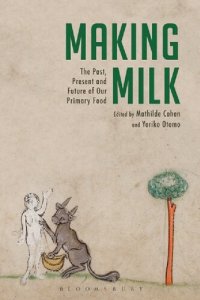
Ebook: Making Milk: The Past, Present, and Future of Our Primary Food
Author: Mathilde Cohen, Yoriko Otomo (editors)
- Year: 2017
- Publisher: Bloomsbury Academic
- Language: English
- pdf
What is milk? Who is it for, and what work does it do? This collection of articles bring together an exciting group of the world’s leading scholars from different disciplines to provide commentaries on multiple facets of the production, consumption, understanding and impact of milk on society. The book frames the emerging global discussion around philosophical and critical theoretical engagements with milk. In so doing, various chapters bring into consideration an awareness of animals, an aspect which has not yet been incorporated in these debates within these disciplines so far.
This brand new research from scholars includes writing from an array of perspectives, including jurisprudence, food law, history, geography, art theory, and gender studies. It will be of use to professionals and researchers in such disciplines as anthropology, visual culture, cultural studies, development studies, food studies, environment studies, critical animal studies, and gender studies.
Milk is a relational substance typically produced by a female mammal for consumption by an infant of the same species. It is produced by as well as for others. But human interventions often result in transforming milk from a caring and relational substance into a vector of oppression. Milk injustices are multiple. Naming or conceptualizing a substance as “milk” or “milky” appears to call for its exploitation for human purposes. This is why this book adopts a non-biological definition of milk, encompassing the full range of milk’s material, affective, historical, semantic, symbolic, and economic relations. The milk at stake here includes the increasing variety of plant and synthetic milks, but also other substances that humans treat like milk. Reading primarily images (art, advertising and photographs) and language (of law, science, and religion), the chapters in this volume examine the relationship between milk and the Church; milk and the state; humans, animals, and plants; technology; capital; gender; and race. They foreground and politicize human and animal milk, appreciating that the two substances are intimately connected and articulating the ways in which they are made to be distinct from one another. They demonstrate how a holistic investigation of milk illuminates relations between humans, in particular along the axes of gender, race, and class, as well as between humans, animals, and plants. Situated in diverse geographical, cultural and disciplinary contexts, the contributions to this volume allow us to ask what milk is, how it is made, and, moreover, what it does.
This brand new research from scholars includes writing from an array of perspectives, including jurisprudence, food law, history, geography, art theory, and gender studies. It will be of use to professionals and researchers in such disciplines as anthropology, visual culture, cultural studies, development studies, food studies, environment studies, critical animal studies, and gender studies.
Milk is a relational substance typically produced by a female mammal for consumption by an infant of the same species. It is produced by as well as for others. But human interventions often result in transforming milk from a caring and relational substance into a vector of oppression. Milk injustices are multiple. Naming or conceptualizing a substance as “milk” or “milky” appears to call for its exploitation for human purposes. This is why this book adopts a non-biological definition of milk, encompassing the full range of milk’s material, affective, historical, semantic, symbolic, and economic relations. The milk at stake here includes the increasing variety of plant and synthetic milks, but also other substances that humans treat like milk. Reading primarily images (art, advertising and photographs) and language (of law, science, and religion), the chapters in this volume examine the relationship between milk and the Church; milk and the state; humans, animals, and plants; technology; capital; gender; and race. They foreground and politicize human and animal milk, appreciating that the two substances are intimately connected and articulating the ways in which they are made to be distinct from one another. They demonstrate how a holistic investigation of milk illuminates relations between humans, in particular along the axes of gender, race, and class, as well as between humans, animals, and plants. Situated in diverse geographical, cultural and disciplinary contexts, the contributions to this volume allow us to ask what milk is, how it is made, and, moreover, what it does.
Download the book Making Milk: The Past, Present, and Future of Our Primary Food for free or read online
Continue reading on any device:

Last viewed books
Related books
{related-news}
Comments (0)